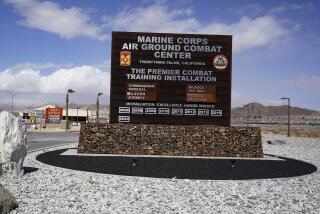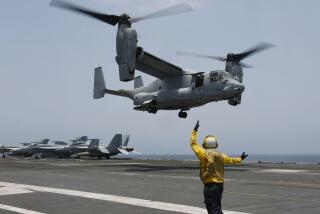The Human Factor
- Share via
Military service is an inherently hazardous occupation, even in peacetime, and in recent months the U.S. armed forces have experienced an unusually long series of costly accidents.
Last year 23 Marines died in two crashes of the V-22 Osprey, a trouble-burdened hybrid that combines helicopter and airplane technology. Last month the submarine Greeneville collided with and sank a Japanese fishing ship, with the loss of nine of the trawler’s crew. Last month also saw the collision of two Army helicopters during a training exercise in Hawaii, killing six men. This month 21 members of the National Guard died in a plane crash in Georgia. And this week misdirected bombs from a Navy warplane killed five Americans and a New Zealander in a training accident in Kuwait.
There is no apparent common thread in these incidents. In some cases they were the result of bad judgment, in others perhaps of faulty equipment or weather conditions. The search for causes continues, though preliminary evidence in both the submarine and Kuwait accidents points to human error. The captain and crew of the Greeneville should have been aware of the location of the Japanese ship relative to the sub and so been able to avoid the collision, which occurred during a rapid ascent exercise. Either the Navy pilot or the Air Force air controller who was directing his practice bombing run in Kuwait made a tragic mistake. The plane dropped three 500-pound bombs not on the intended target but very close to where the air controller and other observers were positioned.
Until this century casualties in the U.S. military due to nonbattle causes outnumbered those suffered in combat. Infectious diseases, food poisoning, mishandled munitions were among the major killers. Weather-related maladies--frostbite and trench foot, for example--transportation and training accidents took high tolls. Improved sanitation, medical care and safety measures have dramatically lowered nonbattle casualties. But not all dangers can be eliminated and not all accidents prevented.
This may be the era of smart weapons and almost unimaginably sophisticated ships and planes. But if there is a single conclusion that can be drawn from the recent string of military accidents it’s that the human element remains paramount. For all that military technology is able to do, in the end it’s individual experience and judgment and care--what people see and hear and choose to do--that count. Prudence is rooted in training, and constant training wins battles and saves lives.
More to Read
Sign up for Essential California
The most important California stories and recommendations in your inbox every morning.
You may occasionally receive promotional content from the Los Angeles Times.













